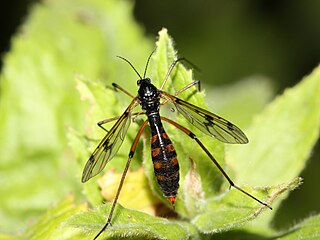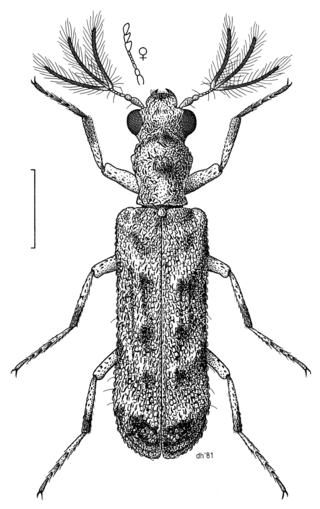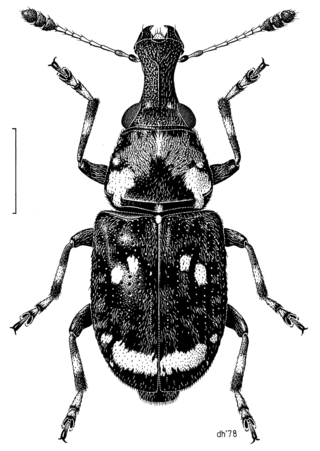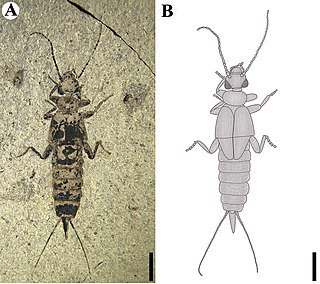Related Research Articles

Weevils are beetles belonging to the superfamily Curculionoidea, known for their elongated snouts. They are usually small – less than 6 mm in length – and herbivorous. Approximately 97,000 species of weevils are known. They belong to several families, with most of them in the family Curculionidae. It also includes bark beetles, which while morphologically dissimilar to other weevils in lacking the distinctive snout, is a subfamily of Curculionidae. Some other beetles, although not closely related, bear the name "weevil", such as the biscuit weevil, which belongs to the family Ptinidae.

The Trachypachidae are a family of beetles that generally resemble small ground beetles, but that are distinguished by the large coxae of their rearmost legs. There are only six known extant species in the family, with four species of Trachypachus found in northern Eurasia and northern North America, and two species of Systolosoma in Chile and Argentina. They were much more diverse in the past, with dozens of described species from the Mesozoic.

Belidae is a family of weevils, called belids or primitive weevils because they have straight antennae, unlike the "true weevils" or Curculionidae which have geniculate (elbowed) antennae. They are sometimes known as "cycad weevils", but this properly refers to a few species from the genera Parallocorynus and Rhopalotria.

Bittacidae is a family of scorpionflies commonly called hangingflies or hanging scorpionflies.

The Ptychopteridae, phantom crane flies, are a small family of nematocerous Diptera. Superficially similar in appearance to other "tipuloid" families, they lack the ocelli of the Trichoceridae, the five-branched radial vein of the Tanyderidae, and the two anal veins that reach the wing margins of the Tipulidae. They are usually allied with the Tanyderidae based on similarities of the mesonotal suture, this group being called the Ptychopteromorpha.

Osmylidae are a small family of winged insects of the net-winged insect order Neuroptera. The osmylids, also called lance lacewings, stream lacewings or giant lacewings, are found all over the world except North and Central America. There are around 225 extant species.

The Bostrichidae are a family of beetles with more than 700 described species. They are commonly called auger beetles, false powderpost beetles, or horned powderpost beetles. The head of most auger beetles cannot be seen from above, as it is downwardly directed and hidden by the thorax. Exceptions are the powderpost beetles, and members of the subfamily Psoinae.

Anthribidae is a family of beetles also known as fungus weevils. The antennae are not elbowed, may occasionally be longer than the body and thread-like, and can be the longest of any members of Curculionoidea. As in the Nemonychidae, the labrum appears as a separate segment to the clypeus, and the maxillary palps are long and projecting.

Nemonychidae is a small family of weevils, placed within the primitive weevil group because they have straight rather than geniculate (elbowed) antennae. They are often called pine flower weevils. As in the Anthribidae, the labrum appears as a separate segment to the clypeus, and the maxillary palps are long and projecting. Nemonychidae have all ventrites free, while Anthribidae have ventrites 1-4 connate or partially fused. Nemonychidae lack lateral carinae on the pronotum, while these are usually present, though may be short, in Anthribidae.

Nemestrinidae, or tangle-veined flies is a family of flies in the superfamily Nemestrinoidea, closely related to Acroceridae. The family is small but distributed worldwide, with about 300 species in 34 genera. Larvae are endoparasitoids of either grasshoppers (Trichopsideinae) or scarab beetles (Hirmoneurinae). Some are considered important in the control of grasshopper populations. Adults are often observed on flowers.

Nannopterygius is an extinct genus of ophthalmosaurid ichthyosaur that lived during the Middle Jurassic to the Early Cretaceous. Fossils are known from England, Kazakhstan, Russia, and Norway and six species are currently assigned to the genus.

Protodiplatyidae is an extinct family of earwigs. It is one of three families in the suborder Archidermaptera, alongside Dermapteridae and Turanovia. Species are known from Jurassic and Early Cretaceous fossils and have unsegmented cerci and tarsi with four to five segments.

Morrolepis is an extinct genus of prehistoric coccolepidid "palaeoniscoid" ray-finned fish that lived during the Late Jurassic and earliest Cretaceous epochs in Europe, Asia and North America.
Auliepterix is an extinct genus of small primitive metallic moths within the family Micropterigidae. The genus is represented by two species, the type species A. mirabilis in the Karabastau Svita of the Upper Jurassic of Kazakhstan and Auliepterix minima in Upper Jurassic-Lower Cretaceous rocks near Khotont Somon in the Mongolian People's Republic.
Kararhynchus is an extinct genus of beetles. Two new species, K. gratshevi and K. jurassicus, were described from the middle Late Jurassic epoch of Kazakhstan by A. A. Legalov in 2012.

Ceutorhynchus is a genus of true weevils in the tribe Ceutorhynchini. There are at least 400 described species in Ceutorhynchus.
Archaeorrhynchus is an extinct genus of weevil from the family Nemonychidae. It is known from the Callovian-Oxfordian Karabastau Formation in Kazakhstan. The type species, Archaeorrhynchus tenuicornis, was named in 1926. Two other species, A. tenuicornis and A. carpenteri, were described from the same locality.

Mesophyletidae is an extinct family of weevils known from a number of genera preserved in Cretaceous amber. The family was first described as a subfamily in the extant family Caridae, and subsequently raised to family status in 2018.
2015 in paleoentomology is a list of new fossil insect taxa that were described during the year 2015, as well as other significant discoveries and events related to paleoentomology that were scheduled to occur during the year.
Geinitziidae is an extinct family of polyneopteran insects, known from the Permian to Cretaceous. They are currently considered to be members "Grylloblattida" a poorly defined group of extinct insects thought to be related to modern ice crawlers (Grylloblattidae). Other authors place them in the extinct order Reculida. Unlike modern ice crawlers, which are wingless, they had large wings, bearing a superficial resemblance to cockroaches, and are thought to have been day-active above ground predators.
References
- ↑ A. A. Legalov (2012). "New Obrieniidae from the Jurassic of Kazakhstan (Coleoptera, Obrienioidea)". Paleontological Journal. 46 (1): 73–78. doi:10.1134/S0031030112010091. S2CID 86433414.